by Col Michael D. Wyly
With nearly a third of the Marine Corps deployed in the desert, opposed by a large tank threat, every Marine ought to be thinking seriously about how to fight tanks. Such thinking raises questions at a number of levels. Confronting a tank-heavy enemy with one of our Marine air-ground task forces (MAGTF) organizations is one thing, a problem to be solved by generals and colonels alike. There is a different set of problems to be solved by companies, platoons, and squads of Marine infantry and for combat service support Marines, problems of close combat against tanks that loom as overriding for a lance corporal and drive into insignificance any theories of fighting the MAGTF. Make no mistake: colonels and generals also need to be vitally concerned about combat at this level.
Marines are infantrymen. The Marine expeditionary force, combined arms force that it is, remains fundamentally an infantry unit. Therefore, Marines ought to be able to answer the question: What does infantry do against tanks in the desert?
Focusing on the company level, this problem is designed to begin a dialog in answer to that question.
Background
You are commanding officer, Company A, 1st Battalion, 7th Marines (1/7). It is 0530, 12 December 1990. Mounted in amphibious assault vehicles (AAVs), you have been moving south to north across the open Southwest Asian desert, following an intensive but indecisive battle against enemy mechanized forces. You, Company B, 1/7, and Company A, 1st Engineers, have been placed under the leadership of commanding officer, 1st Tank Battalion (-) (+), following the battle. He is operating as part of Task Force Mauler, a combined arms task force whose mission is to find and destroy an enemy armored brigade.
Your company includes detachments from the Dragon, TOW, and 81mm mortar platoons. In addition to your tables of organization (T/O) allocations of small arms, automatic weapons, and machineguns, your inventory of weapons includes:
2 TOWs (HMMWV-Mounted)
8 Dragons
6 SMAWs
8 AT4s
27 LAAWs
10 AT (antitank) mines
2 81mm mortars
1st Tank Battalion (-) (+) is the easternmost thrust of a number of multiple thrusts that comprise Task Force Mauler’s move north. As the leading element assigned to 1st Tank Battalion (-) (+), you have been performing reconnaissance and screening missions. The battalion commander, who habitually leads from the front, is moving with a small mobile command group some 1,000 meters to your north and west. Company B, 1/7, is moving slightly behind Company A, two to three kilometers to the west, The engineer company has been moving along with you. The tanks-approximately two companies of them-have been moving behind you.
Situation I: 0600, 12 December
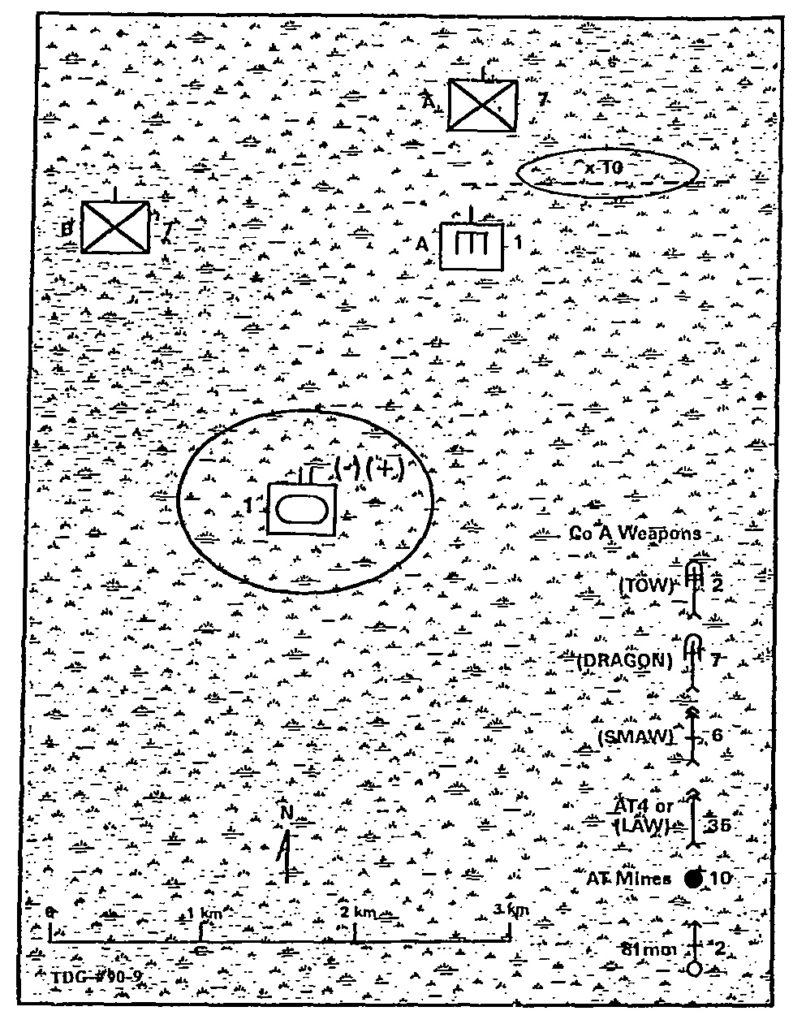 Monitoring the battalion tactical net, you hear the battalion commander order the tank companies to halt. A logistic train is approaching, and it will rendezvous at their present position to refuel and perform maintenance. Though fueling and repair will be conducted as rapidly as possible, the battalion commander thinks it will be three hours before all his tanks are up and ready. All vehicles in the battalion are critically short of fuel, including your AAVs. Priority will go to fueling the tanks, but you must either accommodate the logistic train in your position or dismount and send your vehicles back to where the tanks are fueling, depending on the situation, as the fuel your vehicles have onboard will not last more than another hour. You discuss this over the radio with your battalion commander and halt your company in the position shown on the diagram. By the time you halt, the distance between you and the tank companies has widened to about three kilometers.
Monitoring the battalion tactical net, you hear the battalion commander order the tank companies to halt. A logistic train is approaching, and it will rendezvous at their present position to refuel and perform maintenance. Though fueling and repair will be conducted as rapidly as possible, the battalion commander thinks it will be three hours before all his tanks are up and ready. All vehicles in the battalion are critically short of fuel, including your AAVs. Priority will go to fueling the tanks, but you must either accommodate the logistic train in your position or dismount and send your vehicles back to where the tanks are fueling, depending on the situation, as the fuel your vehicles have onboard will not last more than another hour. You discuss this over the radio with your battalion commander and halt your company in the position shown on the diagram. By the time you halt, the distance between you and the tank companies has widened to about three kilometers.
The battalion commander now calls you on the radio as follows:
The tanks are going to refuel and refit in their present position. The threat is still to the north. It’s possible that 50 to 100 tanks with infantry could be down here in less than an hour. I want the two rifle companies to protect us while we refuel. Alfa, You orient towards the north and east. You are the focus of effort. Bravo, you orient towards the north and west.
1st and 2d Battalions, 11th Marines are both in range to give us artillery support if we need it HMLA-369 is on the deck with 10 UH-1Ns and 10 Whiskey Cobras that can be in action here in less than five minutes. The wing has launched dawn patrols; if any enemy tanks materialize, you can expect EA6Bs and Harriers to attack immediately.
The terrain is fundamentally featureless desert, save the single ridge near Company A’s present position, shown on the diagram. This ridge rises to a maximum of 10 meters in height, is approximately 1,500 meters in length, east to west, and 200 to 300 meters in depth, north to south. Though otherwise featureless at the macro level, it does, of course, offer the normal indentations and depressions that individual infantrymen can use to hide and to afford themselves a modicum of protection. Although approximately level, there is a gentle slope, never more than 3 degrees, downward on either side of the dotted line shown on the diagram.
Requirement I
Who should determine at this point where and how you should position the forces that are at the disposal of Company A-the battalion commander or the company commander?
Assuming the role of either the company commander, the battalion commander, or both, submit your concept for employing Company A and its attachments. Where will they be positioned vis-a-vis the tanks?
Situation II: 0700, 12 December
In the morning twilight, dust plumes are visible on the horizon, following reports from aerial reconnaissance that at least 50 tanks are heading due south, directly towards your position. Aerial recon confirms that the tanks are T-62s. They are followed by as many BTRs, probably carrying infantry. Indications are that they are unaware of your location but are hopeful of locating you and surprising you. U.S. Marine attack air begins its attack 6-8 kilometers north of your position; however, enemy fighters are on the scene as quickly as the Marine planes arrive. You see two Marine Harriers go down, apparently from ZSU-23 fire.
Requirement II
Draw a separate, enlarged diagram of your company position, showing how you will emplace the additional weapons available to you. (See Background above.) Include enough detail in your diagram to show how these weapons are integrated with your T/O weapons and the infantry units of Company A, including, where appropriate, detail at the squad and/or fire team level. (Use of improvised symbols, numbers, or letters to identify weapons is permissible.)
Send your solutions without delay to the Marine Corps Gazette, TDG #90-9, P.O. Box 1775, Quantico, VA 22134.
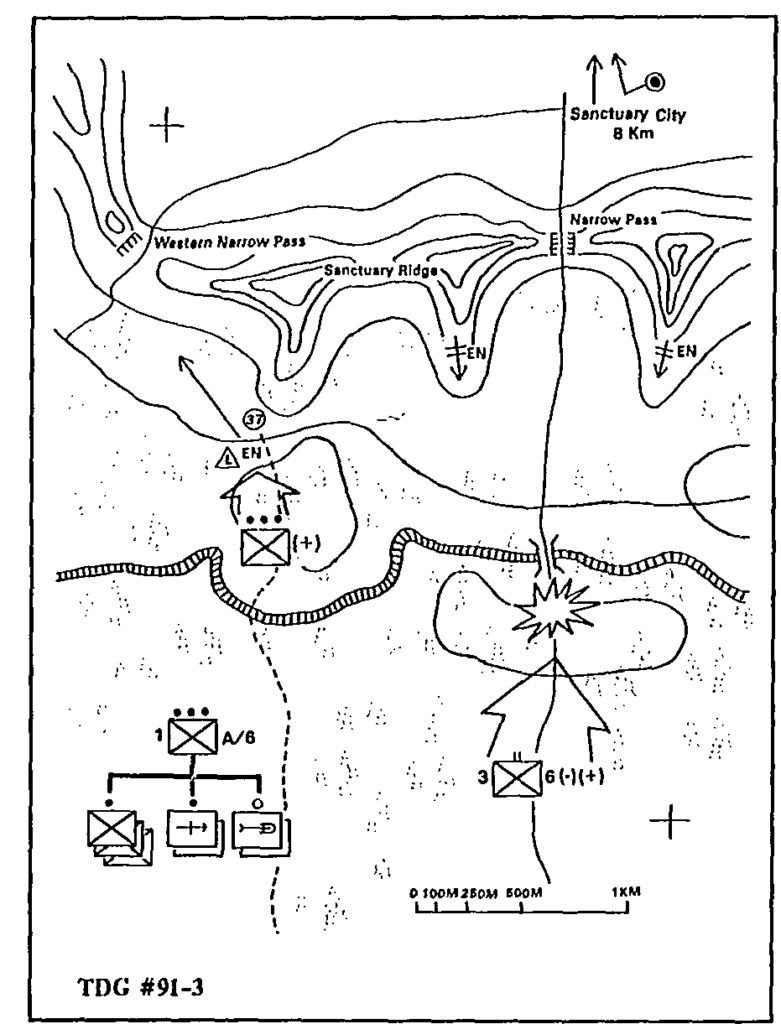 You are the rifle platoon commander of 1st Platoon, Company I, 3d Battalion, 6th Marines. 6th Marines have been attacking north with the intention of destroying enemy forces in Sanctuary Plain and have already landed a helicopterborne company in the plain near Sanctuary City. The helicopterborne force has become besieged, and 3/6 has the mission of launching a relief attack into the plain to reinforce the helicopterborne force and continue the offensive. Implied in this mission is forcing passage into the plain. The terrain south of Sanctuary Ridge is generally rugged and undeveloped with thick vegetation and severe relief. The enemy you have been fighting is primarily infantry with small numbers of tanks. It is 2015, a full moon.
You are the rifle platoon commander of 1st Platoon, Company I, 3d Battalion, 6th Marines. 6th Marines have been attacking north with the intention of destroying enemy forces in Sanctuary Plain and have already landed a helicopterborne company in the plain near Sanctuary City. The helicopterborne force has become besieged, and 3/6 has the mission of launching a relief attack into the plain to reinforce the helicopterborne force and continue the offensive. Implied in this mission is forcing passage into the plain. The terrain south of Sanctuary Ridge is generally rugged and undeveloped with thick vegetation and severe relief. The enemy you have been fighting is primarily infantry with small numbers of tanks. It is 2015, a full moon.



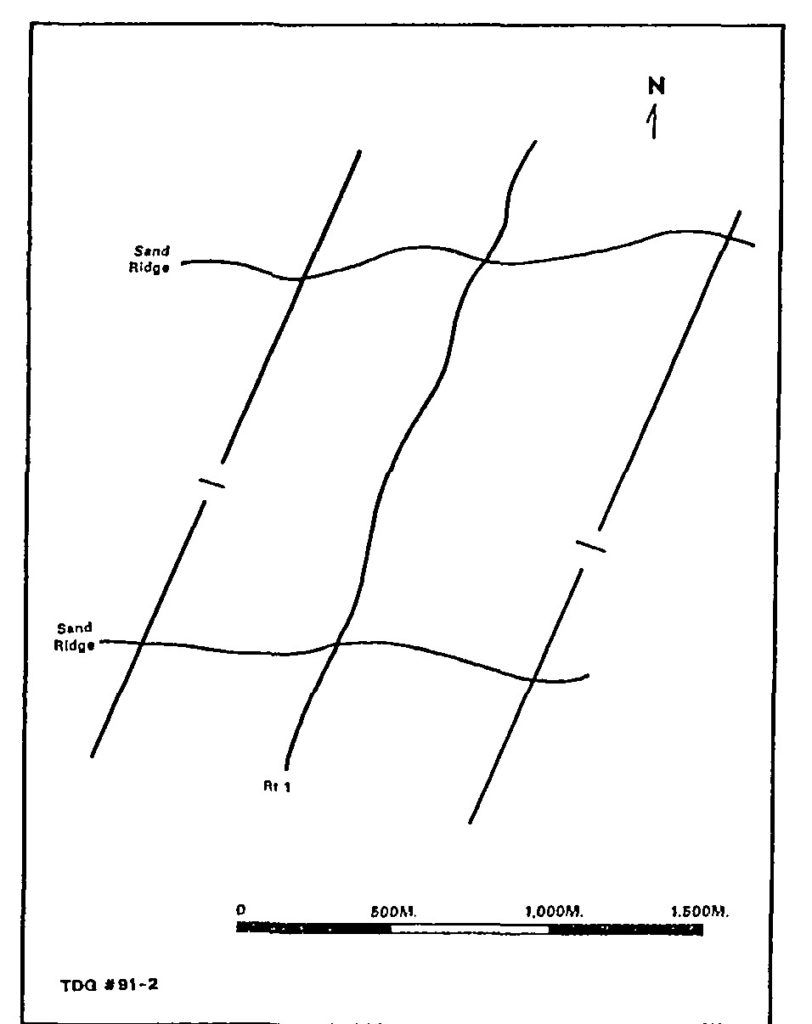 You are a
You are a 
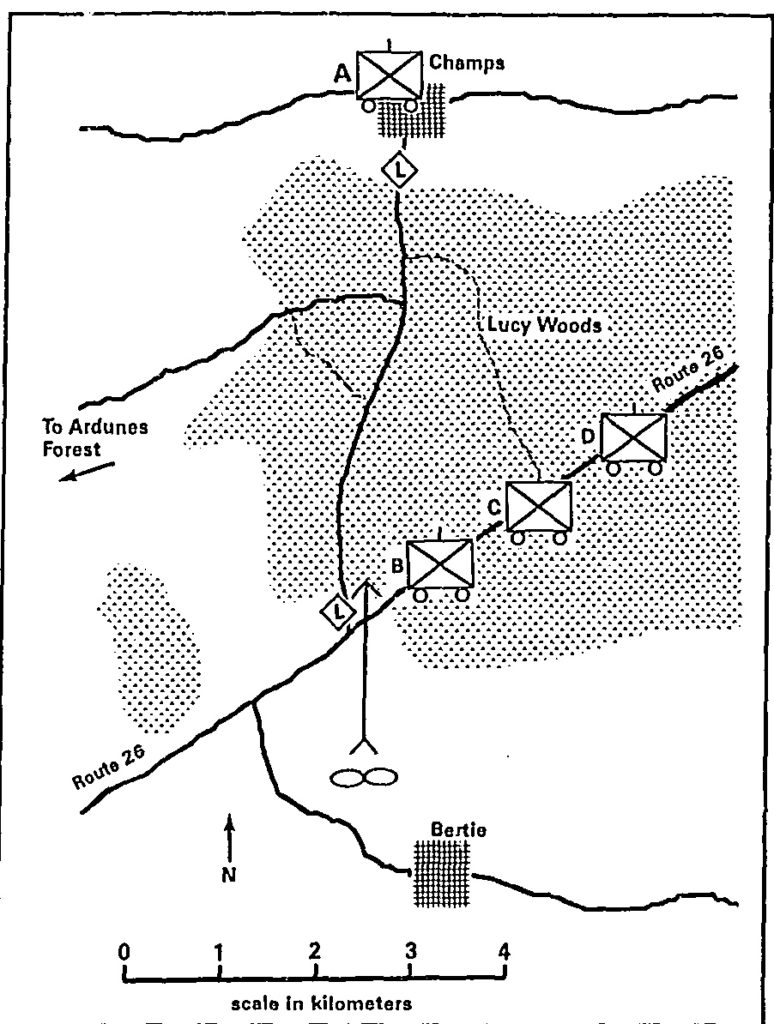 You are the commander of a Marine infantry battalion with the mission of destroying enemy forces that are attempting to move north through the Ardunes Forest (off the map to the west). Your battalion of four rifle companies, a weapons company, and a headquarters and service company are mounted in 5-ton trucks. The major exception to this is your heavy machineguns and Dragons, which are mounted in HMMWVs.
You are the commander of a Marine infantry battalion with the mission of destroying enemy forces that are attempting to move north through the Ardunes Forest (off the map to the west). Your battalion of four rifle companies, a weapons company, and a headquarters and service company are mounted in 5-ton trucks. The major exception to this is your heavy machineguns and Dragons, which are mounted in HMMWVs.
 Monitoring the battalion tactical net, you hear the battalion commander order the tank companies to halt. A logistic train is approaching, and it will rendezvous at their present position to refuel and perform maintenance. Though fueling and repair will be conducted as rapidly as possible, the battalion commander thinks it will be three hours before all his tanks are up and ready. All vehicles in the battalion are critically short of fuel, including your AAVs. Priority will go to fueling the tanks, but you must either accommodate the logistic train in your position or dismount and send your vehicles back to where the tanks are fueling, depending on the situation, as the fuel your vehicles have onboard will not last more than another hour. You discuss this over the radio with your battalion commander and halt your company in the position shown on the diagram. By the time you halt, the distance between you and the tank companies has widened to about three kilometers.
Monitoring the battalion tactical net, you hear the battalion commander order the tank companies to halt. A logistic train is approaching, and it will rendezvous at their present position to refuel and perform maintenance. Though fueling and repair will be conducted as rapidly as possible, the battalion commander thinks it will be three hours before all his tanks are up and ready. All vehicles in the battalion are critically short of fuel, including your AAVs. Priority will go to fueling the tanks, but you must either accommodate the logistic train in your position or dismount and send your vehicles back to where the tanks are fueling, depending on the situation, as the fuel your vehicles have onboard will not last more than another hour. You discuss this over the radio with your battalion commander and halt your company in the position shown on the diagram. By the time you halt, the distance between you and the tank companies has widened to about three kilometers.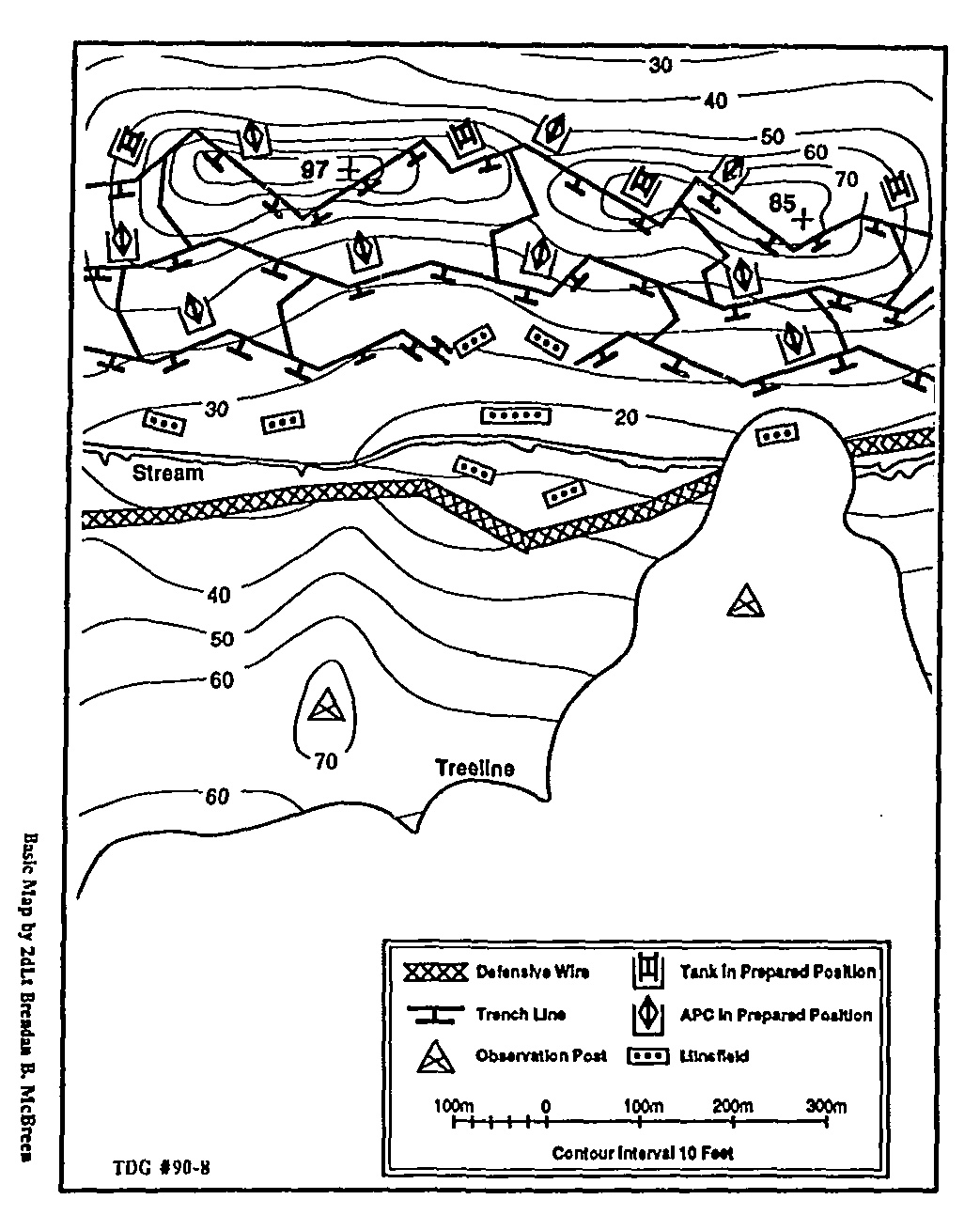
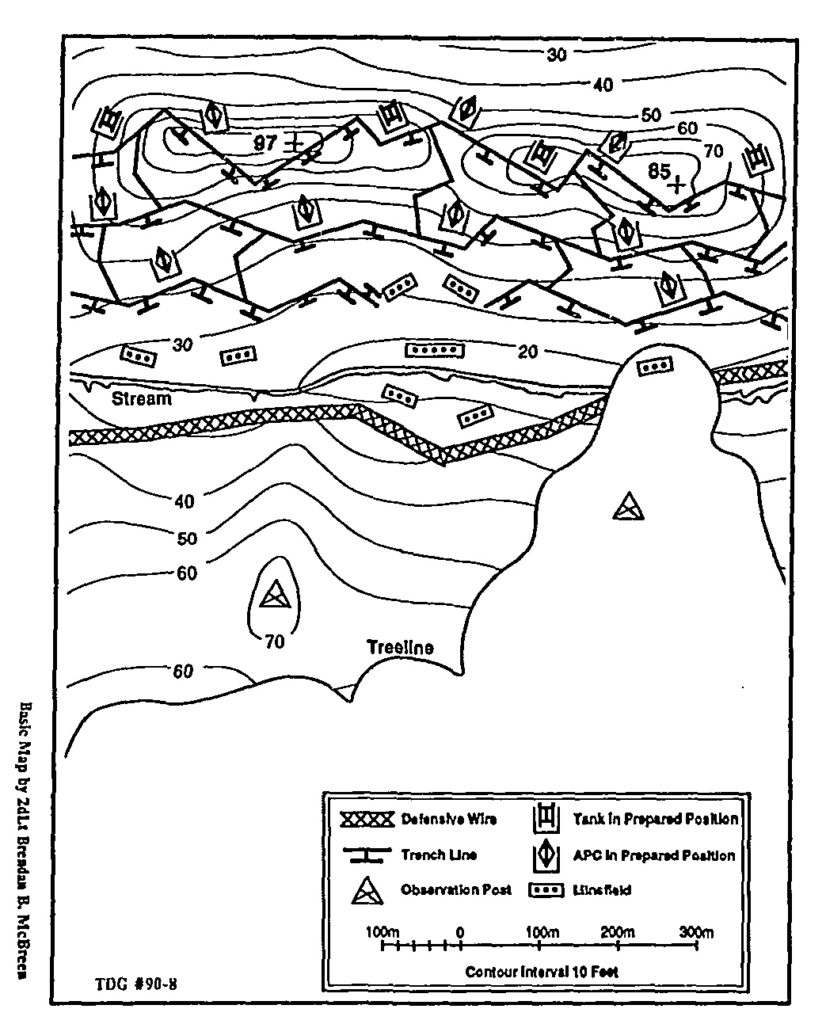 You are the commanding officer of the 3d Battalion, 5th Marines (three rifle companies) reinforced with two platoons of tanks and a combat engineer platoon. You have been in reserve during the initial stages of a deliberate attack by 5th Marines. After overcoming several enemy elements in hasty defensive positions, the regiment encountered a well-developed fortified area, the commanding officer of the 5th Marines gives your battalion the mission of attacking this strongpoint and securing it (creating a gap) so that follow-on mechanized forces can continue the attack against lucrative targets in the enemy rear. In addition to your organic and attached units, you have close air support and artillery fires available to you.
You are the commanding officer of the 3d Battalion, 5th Marines (three rifle companies) reinforced with two platoons of tanks and a combat engineer platoon. You have been in reserve during the initial stages of a deliberate attack by 5th Marines. After overcoming several enemy elements in hasty defensive positions, the regiment encountered a well-developed fortified area, the commanding officer of the 5th Marines gives your battalion the mission of attacking this strongpoint and securing it (creating a gap) so that follow-on mechanized forces can continue the attack against lucrative targets in the enemy rear. In addition to your organic and attached units, you have close air support and artillery fires available to you.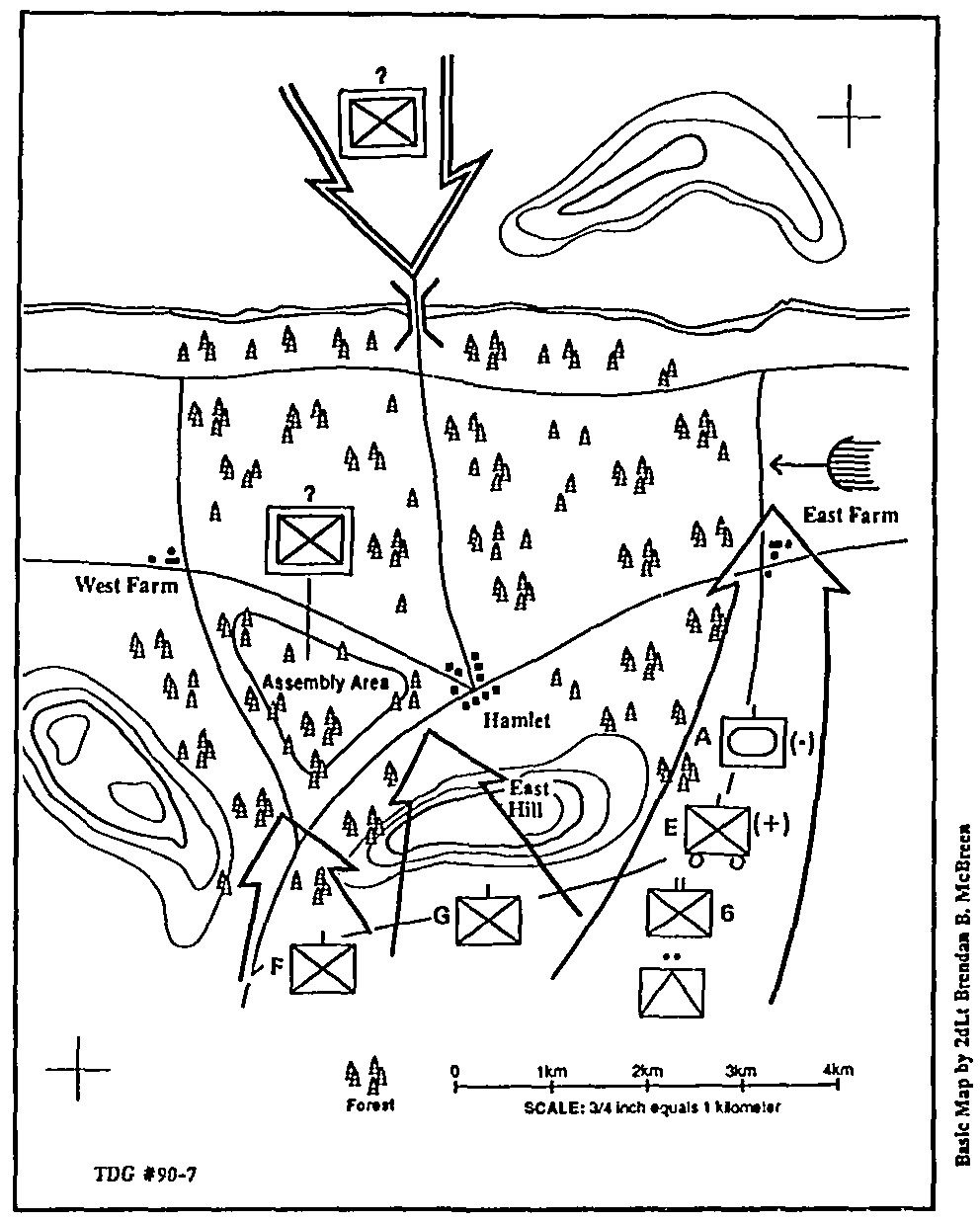
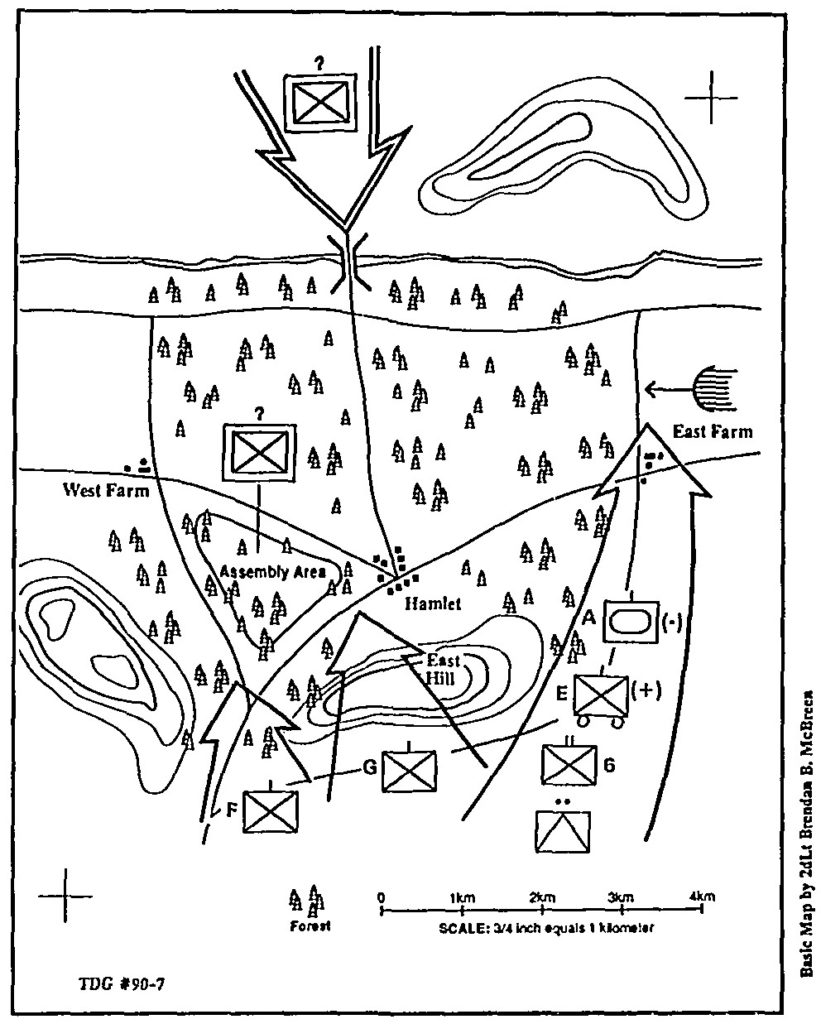 You are the executive officer of 2d Battalion, Sixth Marines consisting of a rifle company on trucks, two rifle companies on foot, a tank company, and a TOW section. As the lead element in a major division offensive, your battalion was moving to an assembly area in preparation for an attack north across the river at 0400 tomorrow morning. Although the assembly area, bridge, and riverbank were supposed to be in friendly hands, at 2000 your battalion discovered this was not the case. An enemy force of at least company size has seized the bridge and occupied your assembly area.
You are the executive officer of 2d Battalion, Sixth Marines consisting of a rifle company on trucks, two rifle companies on foot, a tank company, and a TOW section. As the lead element in a major division offensive, your battalion was moving to an assembly area in preparation for an attack north across the river at 0400 tomorrow morning. Although the assembly area, bridge, and riverbank were supposed to be in friendly hands, at 2000 your battalion discovered this was not the case. An enemy force of at least company size has seized the bridge and occupied your assembly area.
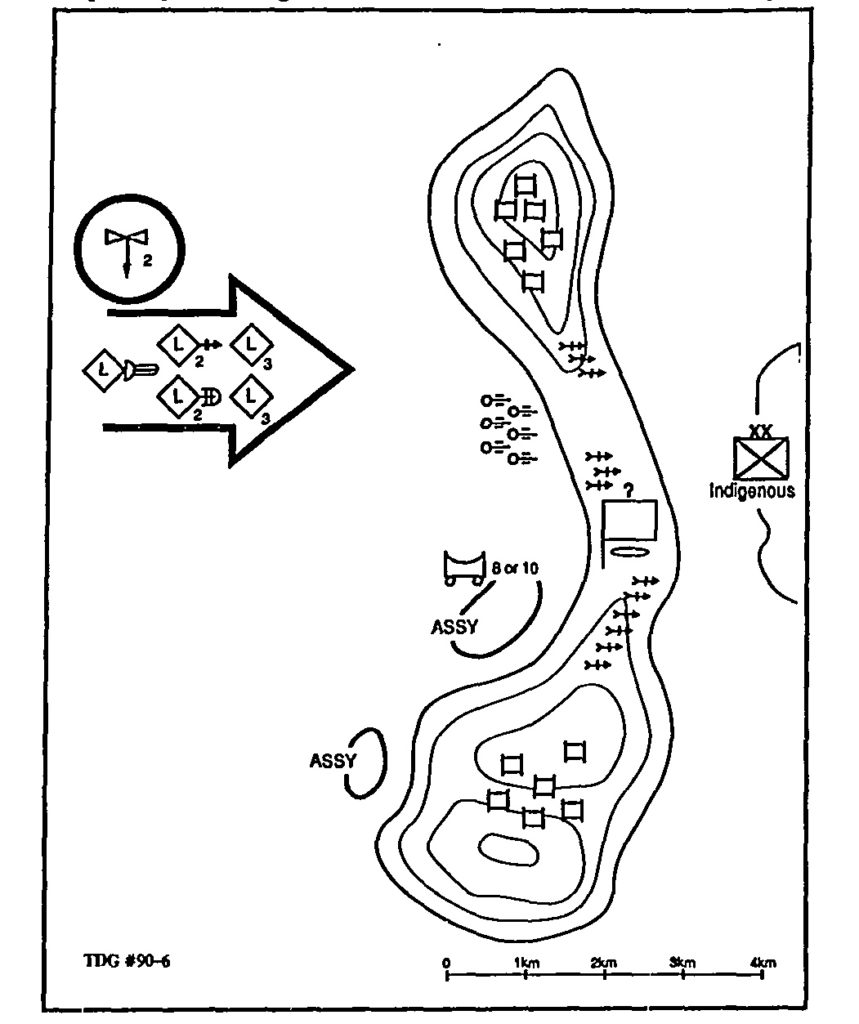 It is dawn, the morning after a typically chaotic and bloody desert battle during Operation HOLY WARRIOR. You are the first sergeant of Company A, 2d Light Armored Infantry Battalion. The company’s last remaining commissioned officer was killed in the opening moments of yesterday’s battle; since then you have commanded the company. As of this morning, Company A consists of six light armored vehicles with 25mm chain guns (LAV-25s) each carrying only two or three scouts; two assault gun variants (LAV-AGs); two TOW variants, (LAV-ATs); and an air defense variant equipped with Stinger, a 2.75 Hydra 70 rocket system, and a 25mm gun (LAV-AD). The 25mm chain gun on the LAV-25 fires He (high explosive) and AP (annor piercing) rounds with a maximum effective range of about 1,500 meters. The 105mm assault gun variant has an effective range of about 2,500 meters. The battalion has been in intense combat for five days running, and you are hoping for a day off to pull maintenance. No such luck: as your gunner heats up the morning coffee, a messenger arrives with instructions to report to the battalion command post immediately.
It is dawn, the morning after a typically chaotic and bloody desert battle during Operation HOLY WARRIOR. You are the first sergeant of Company A, 2d Light Armored Infantry Battalion. The company’s last remaining commissioned officer was killed in the opening moments of yesterday’s battle; since then you have commanded the company. As of this morning, Company A consists of six light armored vehicles with 25mm chain guns (LAV-25s) each carrying only two or three scouts; two assault gun variants (LAV-AGs); two TOW variants, (LAV-ATs); and an air defense variant equipped with Stinger, a 2.75 Hydra 70 rocket system, and a 25mm gun (LAV-AD). The 25mm chain gun on the LAV-25 fires He (high explosive) and AP (annor piercing) rounds with a maximum effective range of about 1,500 meters. The 105mm assault gun variant has an effective range of about 2,500 meters. The battalion has been in intense combat for five days running, and you are hoping for a day off to pull maintenance. No such luck: as your gunner heats up the morning coffee, a messenger arrives with instructions to report to the battalion command post immediately.
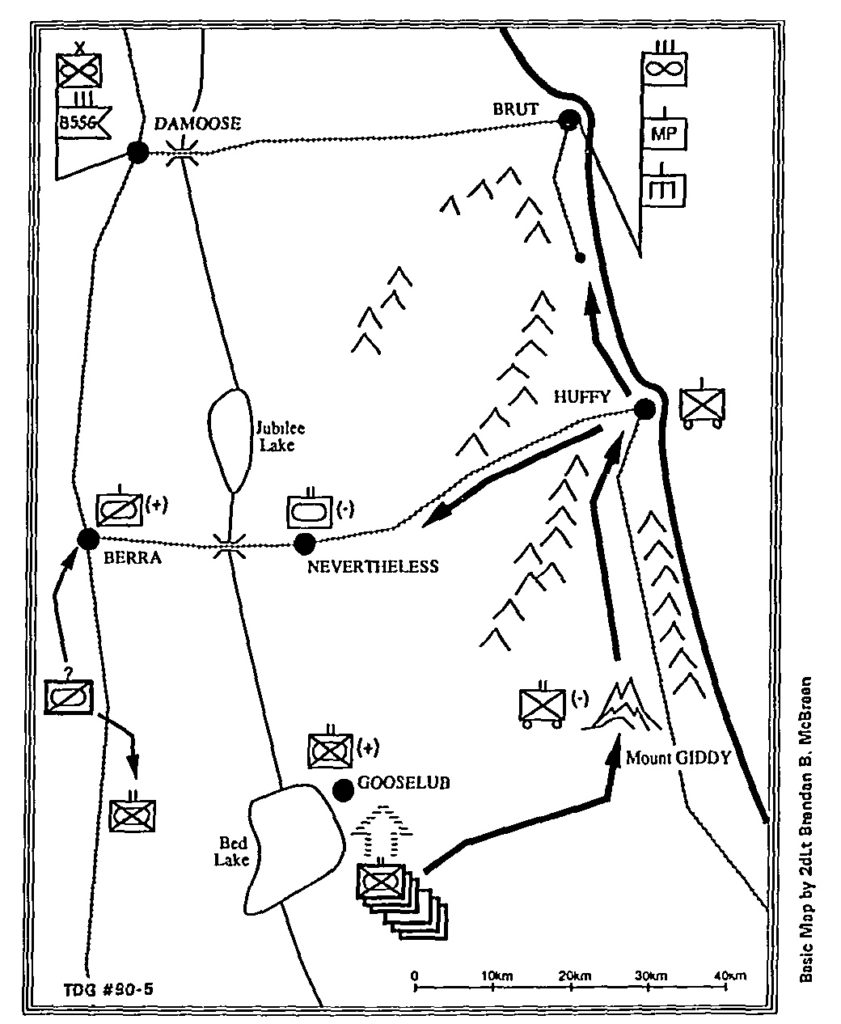 You are a MEB commander fighting in a coastal desert that offers excellent mobility and freedom for mechanized and motorized forces save for
You are a MEB commander fighting in a coastal desert that offers excellent mobility and freedom for mechanized and motorized forces save for 
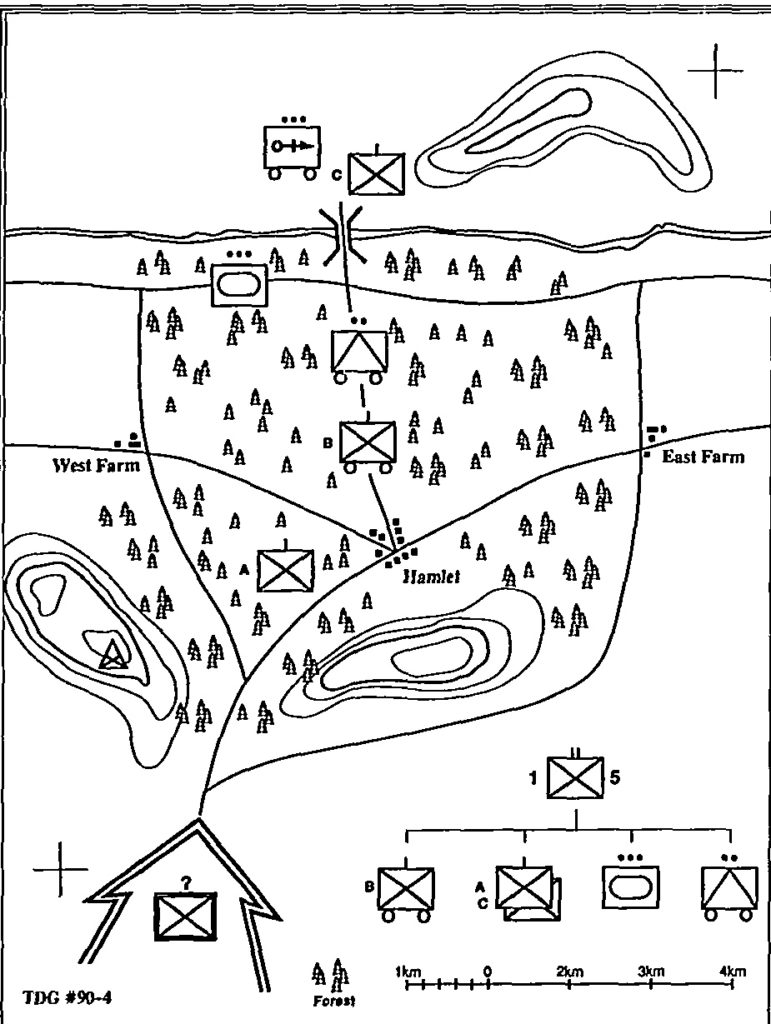 You are the commanding officer, 1st Battalion, 5th Marines. The division is halted temporarily, but the division commander plans to resume the offensive toward the south as soon as logistics can be brought forward. You have been operating north of the river against enemy reconnaissance and security elements. The enemy holds the riverline and the bridge in strength. (You believe the river to be unfordable.) Intelligence indicates that the enemy is planning an imminent offensive north across the river-sooner than your division can be ready to attack in strength. Your mission, which gives you broad latitude in the manner of execution, is to take whatever actions you can to disrupt the enemy attack in your sector.
You are the commanding officer, 1st Battalion, 5th Marines. The division is halted temporarily, but the division commander plans to resume the offensive toward the south as soon as logistics can be brought forward. You have been operating north of the river against enemy reconnaissance and security elements. The enemy holds the riverline and the bridge in strength. (You believe the river to be unfordable.) Intelligence indicates that the enemy is planning an imminent offensive north across the river-sooner than your division can be ready to attack in strength. Your mission, which gives you broad latitude in the manner of execution, is to take whatever actions you can to disrupt the enemy attack in your sector.
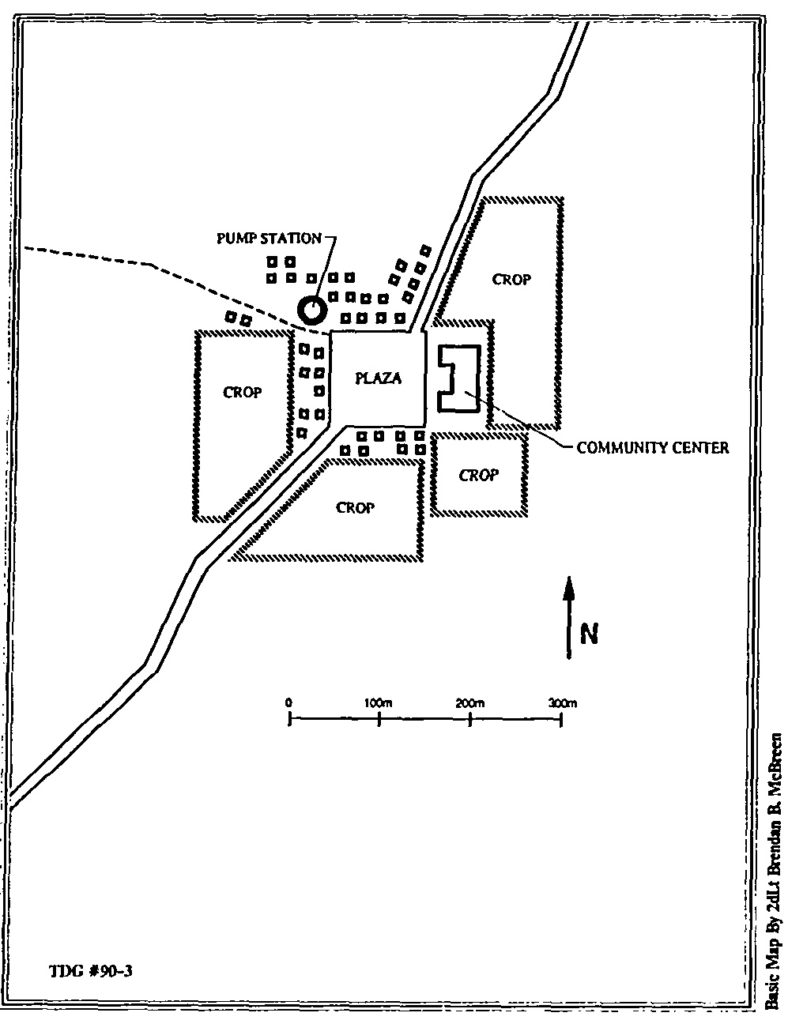 You are a rifle company commander fighting in an arid desert environment that offers exceptional mobility for wheeled and tracked vehicles. You are supported by a platoon of assault amphibian vehicles (AAVs), enough to mount your entire company. After intense fighting at the front for several weeks, the battalion commander has assigned your company to rear duty providing security for the Mobile Combat Service Support Detachment (MCSSD). As the ground combat element (GCE) advances north, the MCSSD plans to move in that direction and establish a forward supply point at Oasis, some 25 kilometers north but still another 25 kilometers south of the front. While the front is generally to the north, there is no clear delineation between friendly and enemy territory; you long ago learned the importance of allaround security. Irregular enemy forces mounted on small trucks and equipped with heavy machineguns are known to operate in the area.
You are a rifle company commander fighting in an arid desert environment that offers exceptional mobility for wheeled and tracked vehicles. You are supported by a platoon of assault amphibian vehicles (AAVs), enough to mount your entire company. After intense fighting at the front for several weeks, the battalion commander has assigned your company to rear duty providing security for the Mobile Combat Service Support Detachment (MCSSD). As the ground combat element (GCE) advances north, the MCSSD plans to move in that direction and establish a forward supply point at Oasis, some 25 kilometers north but still another 25 kilometers south of the front. While the front is generally to the north, there is no clear delineation between friendly and enemy territory; you long ago learned the importance of allaround security. Irregular enemy forces mounted on small trucks and equipped with heavy machineguns are known to operate in the area.
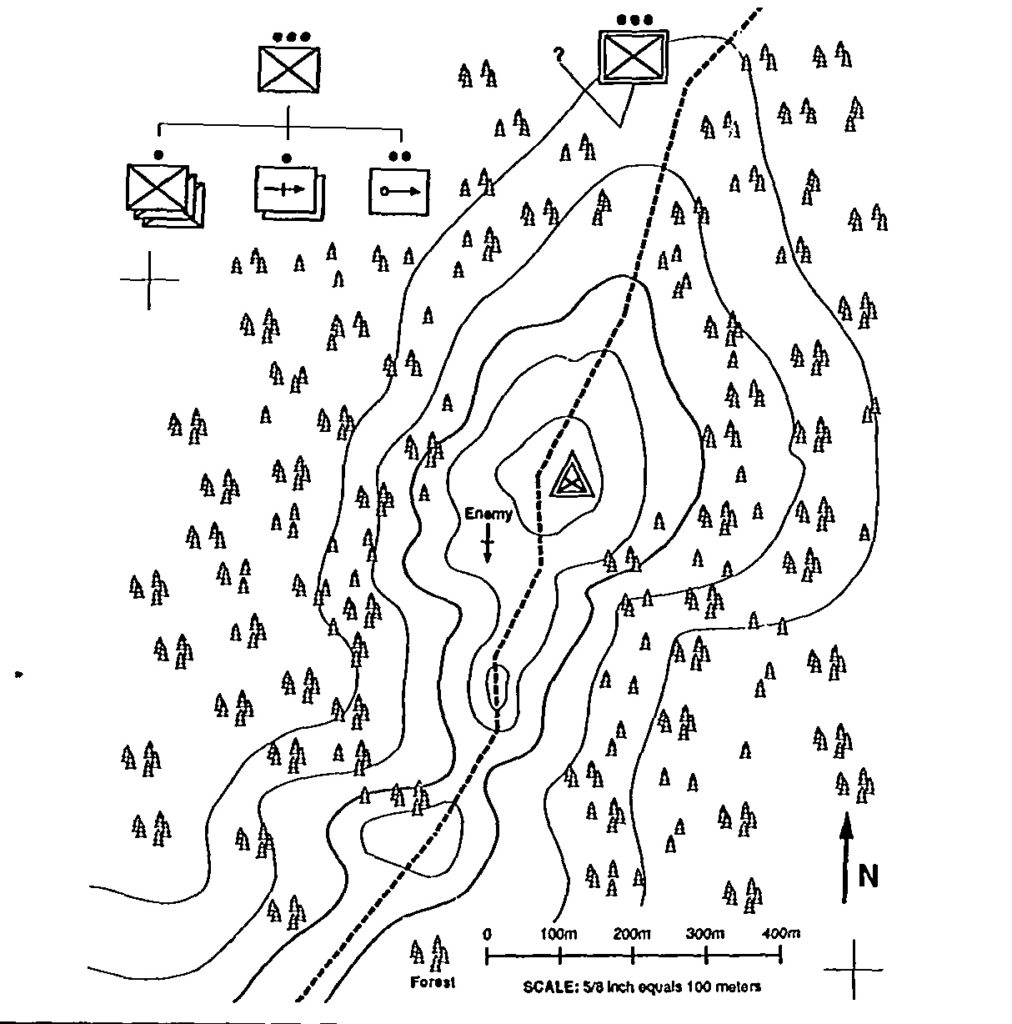 You are a rifle platoon commander fighting in a jungle environment against U.S.-trained and U.S.-equipped forces. The areas not covered by thick forest, such as Knob Hill, are covered by grass three to four feet high. You have been operating in the region for several weeks and are quite familiar with the terrain and the local population, which is generally friendly (but may be just as friendly to the enemy). The company commander gives you the following fragmentary order:
You are a rifle platoon commander fighting in a jungle environment against U.S.-trained and U.S.-equipped forces. The areas not covered by thick forest, such as Knob Hill, are covered by grass three to four feet high. You have been operating in the region for several weeks and are quite familiar with the terrain and the local population, which is generally friendly (but may be just as friendly to the enemy). The company commander gives you the following fragmentary order: